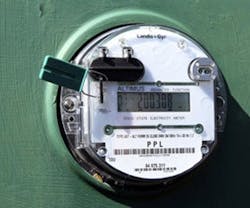Today utilities are giving building owners and tenants price breaks on their electrical service if they use so-called smart grid systems. These appliances and engineered systems can communicate with the electricity provider as part of a demand-response (DR) program, curtailing use and reducing the need for additional generating capacity.
“There is significant impetus, as well as financial incentive, to implement a smart-grid system for those willing to guarantee the demand reduction,” says Terry Hoffman, director of marketing for building automation system (BAS) manufacturer Johnson Controls, Inc. “On a much larger scale, the smart grid connects energy users to a two-way system that communicates pricing information in one direction and usage patterns in another.”
While these new tools, in aggregate, will make the electrical grid more efficient and orderly – reducing blackouts and saving up to 8.8 billion kWh annually within two decades, according to the Electric Power Research Institute, they also raise an opportunity for leaner, greener facility operations, says Hoffman. Using well-integrated BAS systems with smart-grid technology, a building can become more efficient and cost-effective.
A number of organizations with large facility portfolios are investing heavily in smart-grid solutions. The U.S. Postal Service, for example, is installing advanced monitoring and control systems by the provider GridPoint in 2,250 locations nationally. According to the USPS, these use-curtailment technologies – including energy-management systems and submetering tools – will help the agency cut facility energy consumption by 30% by 2015.
Local government agencies, which operate under tight budgets and dwindling tax revenues, are also looking to demand-response equipment, especially when utilities help pay for the installation. The County of Santa Clara, CA, has retrofitted two government buildings to participate in a Pacific Gas & Electric program offering incentive payments for participating in smart-grid DR. Existing thermostats in the municipal buildings were decommissioned and replaced with wireless thermostats from Cypress Envirosystems that are able to communicate with the grid.
The potential of the smart-grid solutions and their impact on BAS technology have attracted the attention of leading engineering and building operations groups. Unusual alliances have resulted, such as the July agreement between Chicago’s Building Owners and Managers Association and the Korean Smart Grid Association along with two of South Korea’s largest energy and technology companies, KT Corporation and LG Electronics. The team announced their plan to use a dozen city office buildings to create a “virtual generator” – that is, enough electricity savings to offset the need for a new power plant – to achieve more effective energy management and save on energy costs.
The BOMA Chicago pilot program is likely to be replicated in other cities. In a nutshell, the alliance employs smart meters, variable-speed drives and digital controls to push down energy consumption while also sharing revenues from utility DR programs. “This will be the first-ever test of the ability of large commercial and residential buildings to effectively aggregate their efforts in a large-scale demand response program,” says BOMA/Chicago’s executive vice president, Michael Cornicelli.
Success stories like these facility rollouts are priming an already fast-growing “cleantech” market, encouraging upgrades to BAS components and networks. According to a recent report by Boulder, CO-based Pike Research, “Networking and communications technologies are at the core of utility smart-grid deployments, and have been the focus of significant attention and fierce debate by industry players.” The analyst forecasts annual shipments of smart-grid communications nodes jumping from 15 million last year to 55 million by 2016, a total market of about $20 billion.
Past the communication nodes, facilities are outfitted with smart meters, which transmit usage data – typically on an hourly basis – to the utilities servicing the properties. Power use to building mechanical and electrical systems is then controlled by smart thermostats, which allow utilities to cycle power on and off for central HVAC systems, as well as smart switches, which can be activated remotely by the electricity provider. A number of appliances are outfitted with the meters or switches, or both, such as lighting controls by makers such as Lutron and washer-dryers made by General Electric.
“Building automation will allow you to control skylight shading, window blinds, HVAC, lights, vents and even micro-generation plants such as solar panels, fuel cells and diesel generators,” says Andreas Antonopoulos, a founding partner with Nemertes Research, Mokena, IL. “This could allow you to adjust your energy consumption and local generation patterns in response to pricing and also hold out the possibility that organizations will be able to sell energy back to the grid.”
In spite of the rapid success of smart-grid systems, there are a few challenges. One of those is the concern that smart-grid communications nodes are vulnerable to security breaches, similar to computer and Internet hacking incidents. An article in the January issue of IEEE Security & Privacy by a team led by Himanshu Khurana at the University of Illinois at Urbana-Champaign concluded, “Although researchers have spent considerable time on smart-grid cybersecurity issues, major problems remain unsolved.”
The authors stressed that solutions offered by utilities – authentication and encryption technologies specifically designed for smart-grid applications – may still need additional work before they meet the robust level of security demanded by many building operators.
For the time being, building professionals will weigh the benefits of increased efficiency and more reliable power against the prospect of security risks.
C.C. Sullivan ([email protected]) is a marketing communications consultant and writer specializing in architecture, design, and construction technology.
